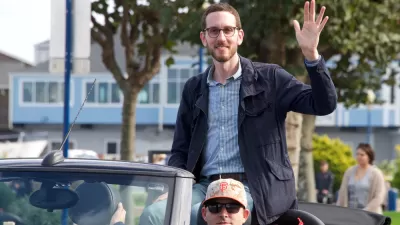"Everything You Think You Know About Housing Is Probably Wrong," reads the headline of this New York Times article.

Michael Kimmelman, New York Times architecture critic, reviews a new show at the Skyscraper Museum in New York City with provocations about the level of understanding among the general public on the subject of housing policy and the housing market.
The show, called "Housing Density," is assessed by Kimmelman as both timely and thought-provoking, and likely to challenge assumptions about planning and cities.
However you calculate it, the word “density” sounds a lot like a synonym for overcrowding and congestion, for too-tall buildings and greedy real estate developers, unwanted neighbors and lost parking spaces. Such associations make the mere mention of the term a Molotov cocktail that opponents of housing initiatives can lob at community board meetings.
This is a big problem. To address the country’s monumental housing crisis and also become less automobile- and carbon-dependent, America needs to densify its job-rich metro areas so that more people can afford to live there and walk, bike and take public transit to get to work and back. According to a much-cited report by the McKinsey Global Institute, California is 3.5 million houses short. Housing shortages exacerbate home prices and homelessness and cause all sorts of other ripple effects on commute times, economic productivity, health and family life.
With plenty of anecdotes of recent controversy over the claims listed above, Kimmelman suggests that the new exhibition is an antidote to the prevailing wisdom among well-to-do NIMBYs and anti-development tenant activists. "Housing Density" points out misconceptions about density, according to Kimmelman, who supports the attempt to push the urban planning discussion in a more productive, healthier direction.
FULL STORY: Everything You Think You Know About Housing Is Probably Wrong

Trump Administration Could Effectively End Housing Voucher Program
Federal officials are eyeing major cuts to the Section 8 program that helps millions of low-income households pay rent.

Planetizen Federal Action Tracker
A weekly monitor of how Trump’s orders and actions are impacting planners and planning in America.

Ken Jennings Launches Transit Web Series
The Jeopardy champ wants you to ride public transit.

Washington Legislature Passes Rent Increase Cap
A bill that caps rent increases at 7 percent plus inflation is headed to the governor’s desk.

From Planning to Action: How LA County Is Rethinking Climate Resilience
Chief Sustainability Officer Rita Kampalath outlines the County’s shift from planning to implementation in its climate resilience efforts, emphasizing cross-departmental coordination, updated recovery strategies, and the need for flexible funding.

New Mexico Aging Department Commits to Helping Seniors Age ‘In Place’ and ‘Autonomously’ in New Draft Plan
As New Mexico’s population of seniors continues to grow, the state’s aging department is proposing expanded initiatives to help seniors maintain their autonomy while also supporting family caregivers.
Urban Design for Planners 1: Software Tools
This six-course series explores essential urban design concepts using open source software and equips planners with the tools they need to participate fully in the urban design process.
Planning for Universal Design
Learn the tools for implementing Universal Design in planning regulations.
Heyer Gruel & Associates PA
Ada County Highway District
Institute for Housing and Urban Development Studies (IHS)
City of Grandview
Harvard GSD Executive Education
Toledo-Lucas County Plan Commissions
Salt Lake City
NYU Wagner Graduate School of Public Service





























